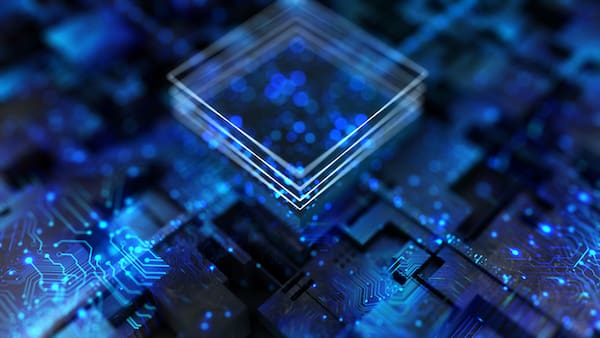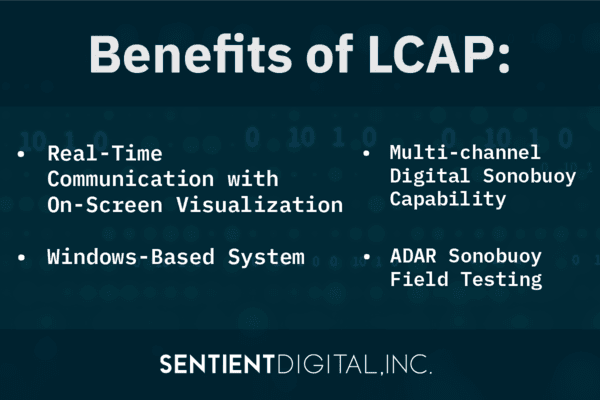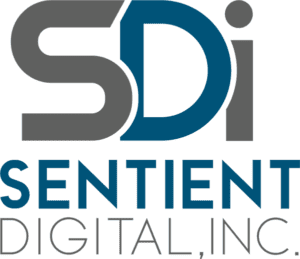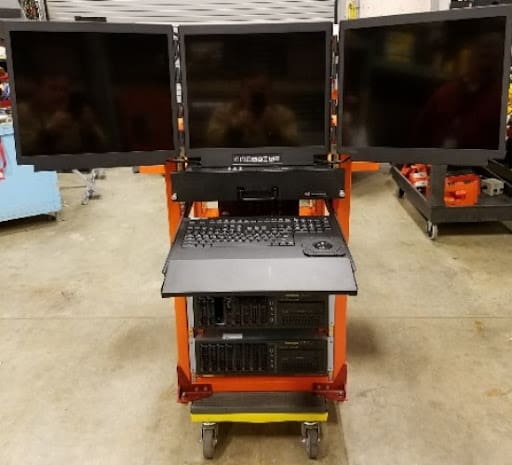The key technical innovation and ongoing enterprise of RDA, Sentient Digital’s acoustical-engineering focused subsidiary, has been the development of a Low Cost Advanced Processor (LCAP) that revolutionizes acoustic testing and processing for sea and air applications. Developed beginning in 2003, LCAP has been continually updated and has adapted to changes in both technology and procedure, meeting the moment to provide optimal solutions. Since LCAP continues to serve an extremely useful role, particularly to the United States Navy, here is an explanation of the technology and why it has been a game changer for R&D and testing functions.
What is LCAP?
As its name would suggest, LCAP is a relatively inexpensive, yet sophisticated, processor that serves as a platform for the development, testing, and evaluation of sonobuoys. The LCAP system utilizes a roll-on, roll-off Anti-submarine Warfare (ASW) acoustic test bed, making it simple to transport for in situ testing. Since it is Windows-based, LCAP is a user-friendly research and development platform that is highly effective. RDA helps design sonobuoys that use LCAP as their processing software and supports efforts to build them with private contractors. LCAP can display acoustic information on a screen, making it easier to analyze the results of acoustic testing and make corrections for any problems that occur during the testing process. While initially used primarily for R&D applications, LCAP now also facilitates sonobuoy lot testing as well.
Acoustic Testing Before LCAP
The impact of LCAP on the acoustic testing landscape becomes clear when examining the procedures and technology that preceded it. Before the development of LCAP, most of the process was manual, without the support of automation. At sea the Navy deployed its R&D sonobuoys over the side of its vessels. The sonobuoys conducted analysis, and their results were recorded on magnetic tape. This method meant that real-time processing and transmission of results was impossible; instead, the acoustic testing results could only be reviewed following completion of data collection. This could also result in costly errors, because if the sonobuoys ran into a problem, they could not communicate that data to the vessel in real time via a visual medium like a screen.
In the realm of aviation, advanced buoy (and especially digital buoy) testing was held back by the state of the available avionics and mission software. There was also a cost issue, in that it was prohibitively expensive to update the software to keep pace with development of more advanced sonobuoys.This data was also recorded on magnetic tape, which suffered from quality and durability issues that could interfere with accurate recording; the tape could also degrade over time, damaging the permanency of results.

History of LCAP
Beginning in 2003, RDA developed LCAP to change the way ships and aircraft control and receive data from sonobuoys. Over time, RDA has continued to adapt and upgrade over time to keep pace with technological and policy changes. For example, when the U.S. Navy recently transitioned from using the P-3C Orion aircraft to P-8A Poseidon aircraft, RDA adapted LCAP to work with the new systems. Through continued development, the LCAP system has remained useful and continued to meet the challenges of the moment for nearly twenty years. During that time, RDA has built, delivered, and flown with thirteen LCAP systems for the P-3C Orion, as well as nine LCAP systems for the P-8A Poseidon. During these flights, LCAP has supported project types including Extended Echo Ranging (EER), Improved Extended Echo Ranging (IEER), Multistatic Active Coherent (MAC), Light Airborne Multi-Purpose (LAMP) System, Deep Extended Echo Ranging (DEER), Battlespace Tactical-Environment Characterization (BTECT), and Defense Advanced Research Projects Agency (DARPA). RDA will continue to refine and enhance the LCAP system to keep pace with clients’ needs and anticipate changes in the state of the industry.
Why LCAP is a Game Changer for Acoustic Testing, Processing, and Results Recording
RDA’s LCAP is a game changer because it addresses all of the problems that preceded its development. Its ability to record transmitted data in real time from sonobuoys has been a major upgrade to the acoustic testing process, particularly as it allows for on-screen visualization of sonobuoy data. Previously, when deploying sonobuoys for underwater acoustic testing, there was little real-time visualization of data. This addresses both the need to correct if problems are encountered and the need for a more reliable recording technology than the previously standard magnetic tape. The real-time data available from buoys using LCAP makes the acoustic testing process much more efficient and reliable, particularly by allowing for adjustments while testing is ongoing.
LCAP Features
The LCAP system’s features allow it to provide a user-friendly experience with valuable real-time data in an efficient manner that saves time and money. RDA designed LCAP and continues to update it in order to provide a high-tech yet affordable solution for acoustic testing, sonobuoy lot testing, R&D functions, and more. LCAP’s features include compatibility with Acoustic Engineering, Underwater Acoustics, and Acoustics Research and Development. Most importantly, at present, LCAP is the only software capable of commanding, controlling, and recording all data from all of the U.S. Navy’s sonobuoys, including those currently in use as well as prior, under-development, and experimental versions.
One of the most useful attributes of LCAP is its versatility. It can be used in conjunction with passive and active SONAR, as well as its tactical applications. In terms of necessary certifications, LCAP has flight clearance onboard the P-8A Poseidon fixed-wing naval aircraft. It can also be used onboard naval research vessels and Navy labs.

The Attributes of LCAP’s Screen Display
LCAP’s displays are a key part of why the LCAP system is a game changer, so they have been continually enhanced over time. The ASCAN features of the system include Matched Filter MofN, Automatic and Manual Detection, Correlated Cursor, Zoom In and Out, and Time Align and Scroll. The system’s Passive Broadband and Association of Narrow Band features include the capacity for multiple buoys, GRAM, ALI, BTH, Zoom, Time Sync, and Colorized Brgs. LCAP also has the following Geotac features: bathymetry, ownship, and sonobuoys data; active, passive, and manual modes; RADAR, Automatic Identification System, and shipwreck capabilities, and ruler and symbol insertion.
LCAP Works With A Radio Frequency Interference Collection System
Another key feature of LCAP is its use of a Radio Frequency Interference Collection System (RFICS). As mentioned, LCAP is Windows-based and RFICS works with its R&D functions.The real-time radio frequency data collected, in full fidelity via four radio antennae operating simultaneously, helps to avoid sonobuoy or acoustic mission system issues caused by interference from these signals. In so doing, RFICS saves time and money that would otherwise be spent on remedying damage caused to testing without the interference being known. LCAP with RFICS can serve a backup and retrieval function for acoustic data. RFICS is able to immediately reconstruct flights as well using secondary GPS. With this useful additional information, LCAP can more efficiently process signals without confusion from radio frequency interference.
The Benefits of LCAP
The benefits of the LCAP system include its real-time communication of results and potential problems, allowing engineers and operators to make adjustments during the testing process, as well as beginning to interpret data while the test is ongoing. Additionally, with LCAP the need for fleet avionics upgrades, as well as acoustic sensor software upgrades, both of which may be expensive, is minimized. Another significant benefit of LCAP is its multi-channel digital sonobuoy capability and ADAR sonobuoy field testing.
RDA Is a Leader in Acoustic Testing, Systems Engineering, Software Development for SONAR Systems, and More
RDA has many years of experience supporting U.S. warfighters with advanced technology, with a primary focus on acoustical engineering services, RDA’s core competency. Since 2003, LCAP has innovated in the sonobuoy control and testing space. As RDA continues to support the U.S. military, expanding into international markets will allow more places in the world to benefit from LCAP’s innovation.
RDA is able to achieve continuous technical innovation because of the strength of its team. RDA’s experts stay current on technology and policy developments by attending events relevant to the industry, and enjoy taking on additional responsibilities to serve organizational objectives. To learn more about RDA’s work, this Mission Software Solutions page discusses LCAP and other aspects of RDA’s commitment to its core competency of acoustical engineering. If you are interested in working with RDA or SDi, learn more about available career opportunities here.




